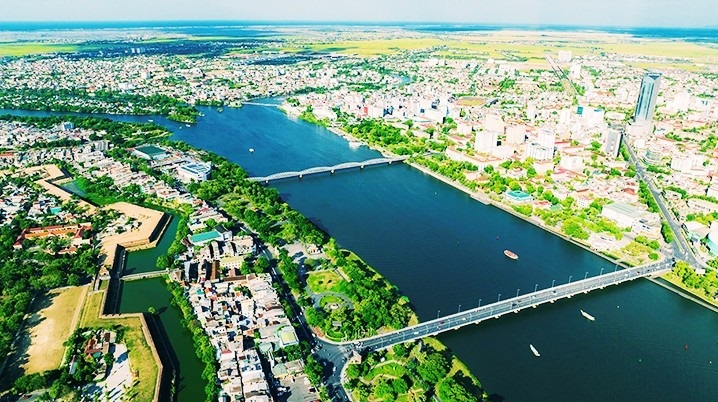The National Assembly has passed a resolution on establishing the centrally-governed Hue City, with over 95% of the vote in favour, marking an important milestone in the nearly 720-year history of the former imperial capital city. The event opens a promising new chapter for this heritage city.

More and more bridges are connecting the two banks of the Perfume River.
720 years and counting
Hue today is a simple yet dignified painting, where the glorious past blends with strong aspirations for growth. Since the Complex of Hue Monuments gained recognition as a UNESCO World Heritage site, Hue has not only preserved the essence of history but also become a vibrant cultural symbol demonstrating the enduring vitality of Vietnam’s heritage.
After two decades of planning and development, Hue is gradually becoming a worthy cultural heritage city, maintaining traditional values while building foundations for a sustainable future.
In the hearts of its people and the whole country, Hue rests gently beside the Perfume River, connecting heritage with modern development. The clear and serene Perfume River reflects the images of the citadel, monuments, and ancient temples like a flowing storyteller.
From its source in the Truong Son mountain range, the Perfume River has nurtured a distinctive culture with royal court music, poetry, and painting. The love for Hue lies not only in its quiet, ancient beauty but also in the shared aspirations of heritage enthusiasts.
In a small house along Ong Ich Khiem Street, on the northern bank of the Perfume River in what will soon be Phu Xuan District, 78-year-old Nguyen Mau Tuan sips a cup of hot tea, his eyes gazing distantly toward Truong Tien Bridge.
He has spent his entire life in this ancient capital, witnessing countless historical ups and downs. Tuan says: “How can I not be happy! Hue has long been beautiful, and now it’s being recognised as a centrally-governed city - that’s a great honour. Our ancestors would surely be proud.”
Tuan recalls the difficult years when the ancient capital was quiet, life was lacking in many ways, and natural disasters were frequent. But now, he clearly feels the transformation - the roads are more well-maintained, people are increasingly conscious about preserving their culture, and especially heritage values are being cherished more than ever.
“Hue hasn’t always been just an ancient capital. The next generation will live in a city that maintains its old soul while developing in modern ways. That’s truly wonderful beyond words!”
Le Thi Nghia, 72, who lives on Ngu Binh Street near Nam Giao Temple, has been connected to this land since it was still quiet and sparsely populated. Her memories are of days when the southern bank was still considered remote in the minds of those living within the Citadel.
She recalls: “In the past, travelling from the Citadel to this side was like taking a long journey. The roads weren’t convenient, there were only a few bridges, and people from the northern bank were hesitant to come to this side. But now the roads are smooth, traffic is bustling, and people from both sides meet and say ‘I’m from Thuan Hoa District, which district are you from?’ - how delightful!”
Positioning Hue’s future
Times are changing, and Hue is gradually expanding. New bridges are being built one after another, with Nguyen Hoang Bridge soon to connect the two banks of the Perfume River. Near Nam Giao Temple, new houses are emerging, and streets are becoming more vibrant. Nghia smiles: “Now nowhere is far anymore. The city is expanding, and it’s convenient for people from both sides to visit each other.”
Phan Nguyen Phuong Nam, a 25-year-old young man born and raised near Bai Dau Bridge along the Dong Ba River in Phu Binh Ward, carries memories of a peaceful but isolated small neighbourhood far from the city centre.
“In the past, when I was little, this was like a hidden corner of Hue. Houses were sparse, and the roads were narrow and winding. Every time my parents took me to the city centre, I was so excited - it was like a reward for being well-behaved,” Nam reminisces, his eyes gleaming with nostalgia.
Time has passed, and Hue changes daily. Roads have expanded, and the Bai Dau area is no longer a remote village but has become a vibrant, more modern part of the city.
“Now, it takes just a few minutes to reach shopping centres, and I can visit supermarkets like Aeon Mall or Go! on weekends - that old feeling of being disconnected is gone,” Nam says with simple joy.
Learning that Hue has officially become a centrally-governed city, Nam’s pride suddenly overflowed. “As a young person, I understand that my responsibility isn’t just to enjoy the achievements of previous generations, but also to contribute to developing Hue even further. This city isn’t just a heritage - it’s our future.”
The good news has sparked joy not only in the hearts of Hue’s people but has spread throughout all regions. This joy affirms the enduring value of the ancient capital.
The newly established Hue City borders Da Nang, Quang Nam Province, Quang Tri Province, the Lao People’s Democratic Republic, and the East Sea. According to the National Assembly’s Resolution, which will take effect from 2025, Hue is a centrally-governed city encompassing the entire natural area of over 4,900 square kilometres and a population of approximately 1.2 million people from Thua Thien Hue Province.